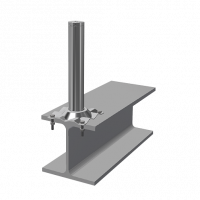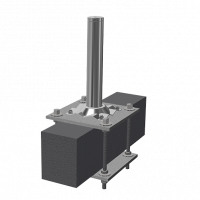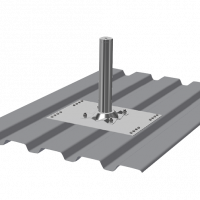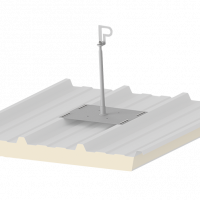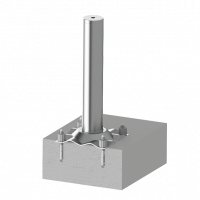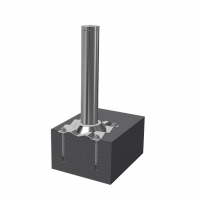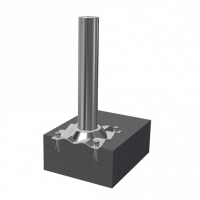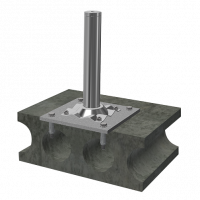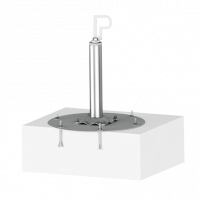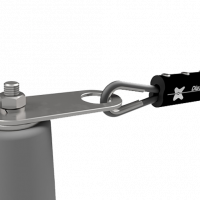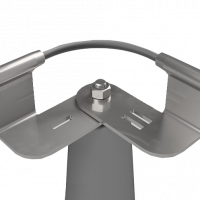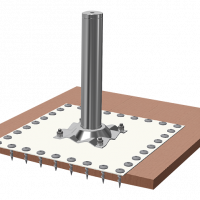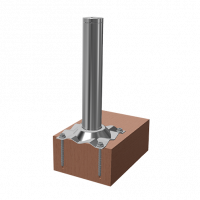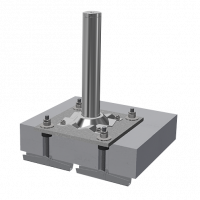Drive over or not
Efficient lifeline system
A lifeline system consists of at least two attachment points that are connected with a stainless steel rope. This allows you to secure yourself with a belt, safety rope and a lanyard when stepping on the roof area.
Solution for every surface
Cable systems for every roof
metal
concrete
Green roof
wood
Push-through mounting
Seculine Vario type 6
Unscrew
Seculine Vario type 7
Clamp fastening
Seculine Vario type 9
Unscrew
Seculine Vario type 15
Unscrew
SECU Green Line end support
Load without penetration
SECU Green Line end support with rope tensioner
Load without penetration
SECU Green Line corner support that can be driven over
Load without penetration
SECU Green Line traversable intermediate support
Load without penetration
Seculine Vario type 5
Unscrew
Seculine Vario type 7
Unscrew
Seculine Vario type 8
Unscrew
Seculine Vario type 12
Push-through mounting
What is a lifeline system?
When it comes to fall protection, a lifeline system is a good option. Because the different types of lifeline systems ensure that work at heights on roofs or other flat surfaces can be carried out with the necessary safety.
A lifeline system always consists of at least 2 anchor devices that are connected with a stainless steel rope. In this way, people can attach themselves to the rope with a personal safety device, a tether, a safety rope and a lanyard and are thus secured against a fall. The system can be distributed over the entire surface and thus also guarantee fall protection for large areas, depending on the number and alignment of the individual anchorage devices.
A lifeline system must always be seen in connection with personal fall protection, because the system ensures the connection between personal fall protection and the structure and thus provides fall protection. Lifeline systems are used as restraint systems. This means that the system ensures that the leading edge cannot be reached. This prevents falls. However, they can also be used in different ways as a fall arrest system, which intercepts the fall in the event of a fall.
There are different types of lifeline systems, which differ significantly in the type of installation and can therefore equip different types of work and areas with the necessary fall protection.
What are the different lifeline systems?
Depending on the location and the local conditions, the various lifeline systems are differently suitable. There are 3 different ways of attaching a lifeline system and thus ensuring a high level of fall protection.
- Vertical lifeline systems
- Horizontal lifeline systems
- Lifeline systems upside down
The different types usually differ according to the assembly, i.e. how a cable system is attached. The functionality is mostly the same, although differences can also be made here.
- Fully traversable lifeline systems, these are equipped with gliders and make it possible to glide over the entire system without having to hang around. This makes work much easier for the workers. This makes a lot of sense, especially with systems that go around curves or are equipped with several intermediate supports.
- Safety rope systems that cannot be fully traversed, here it is necessary to manually place the safety device over the intermediate supports. The safety device must be removed from each intermediate support and placed behind the next support.
How does a vertical lifeline system work?
Vertical lifeline systems are mostly used when it comes to climbing protection. That means securing when climbing on ladders or permanently installed climbing options. The safety rope runs next to the ascent option and the person secures himself to the safety rope with a lanyard and retaining straps. It is important to use a lanyard with a damper, such as a fall arrest device, for the correct fall protection.
This type of lifeline system can also be found more and more in the mountains, which is increasingly being designed for the broad masses of tourism. Thanks to these safety systems, even inexperienced climbers can climb to great heights using fixed ladders.
When it comes to occupational safety, it is important to work safely at heights. This type of lifeline system is particularly popular when climbing high posts or raised roofs.
How does a horizontal lifeline system work?
Horizontal lifeline systems are mostly used on flat roofs or other flat surfaces to provide fall protection.
Such a system is based on individual attachment points that are connected with a stainless steel cable. The various attachment points differ as end brackets and intermediate supports.
In order to ensure that the force on the ground is not too high in the event of a fall, force limiters have to be installed again and again. These ensure that the forces that act on the subsurface are limited and thus for even more safety and good stress.
- Systems that run straight
In the case of straight horizontal lifeline systems, it is sufficient to install a force limiter.
- Curvy systems
If horizontal lifeline systems run over curves, it is necessary to install 2 force limiters. The number of curves is not relevant here; this is true even if there is only one curve. It is also important that the end brackets and intermediate supports are specially reinforced at the curves, because this is the only way to prevent them from bending over time.
These safety systems in particular are designed as fully traversable lifeline systems, which makes work much easier and makes it unnecessary to repeatedly lift the safety device over the intermediate supports.
How does an upside down lifeline system work?
The upside down lifeline system is a variant of the horizontal systems. The big advantage here is that these systems can also be used in very narrow areas and can be used both as a fall arrest system and as a restraint system.
In both cases, a very high level of security can be ensured here. If the upside down lifeline system is used as a fall arrest system, it is particularly important to ensure that it is handled correctly, as this is the only way to catch a fall correctly.
What are the advantages of a lifeline system?
Like all fall protection systems, lifeline systems offer protection from or in the event of a fall. A lifeline system can be used both as a prevention, i.e. as a restraint system, and as a fall arrest system. In this way, the various systems can be optimally used and offer excellent secondary, i.e. individual, fall protection.
Injuries can therefore be avoided by avoiding a fall in advance, or serious injuries can be avoided by intercepting the fall. But that's not all.
These systems also ensure the personal feeling of security when working at heights. In this way, work can be carried out without fear, which not only increases the personal feeling of security, but also the quality of the work.
And that's not all, unlike other personal fall protection systems, with the lifeline systems it is possible for several people to be secured at the same time. In this way, several people can secure themselves and are still secured by personal fall protection. The flexible installation options are also a great advantage for the lifeline systems. In this way, the upside-down systems can also be effectively attached in particularly narrow areas and provide good fall protection.

